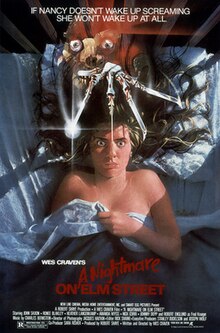| A Nightmare on Elm Street | |
|---|---|
 Theatrical release poster | |
| Directed by | Wes Craven |
| Written by | Wes Craven |
| Produced by | Robert Shaye |
| Starring | |
| Cinematography | Jacques Haitkin |
| Edited by |
|
| Music by | Charles Bernstein |
Production companies |
|
| Distributed by | New Line Cinema |
Release date |
|
Running time | 91 minutes[2] |
| Country | United States |
| Language | English |
| Budget | $1.1 million[3] |
| Box office | $57 million[4][5] |
A Nightmare on Elm Street is a 1984 American supernatural slasher film written and directed by Wes Craven and produced by Robert Shaye. It is the first installment in the A Nightmare on Elm Street franchise and stars Heather Langenkamp, John Saxon, Ronee Blakley, Robert Englund as Freddy Krueger,[6][7] and Johnny Depp in his film debut. The film's plot concerns a group of teenagers who are targeted by Krueger, an undead child killer who can murder people through their dreams, as retribution against their parents who burned him alive.[8]
Craven filmed A Nightmare on Elm Street on an estimated budget of $1.1 million.[3] The film was released on November 9, 1984, in limited theaters until its nationwide theatrical release on November 16, 1984, and grossed $57 million worldwide.[4][5] The film received critical acclaim upon its release, and has since been considered to be one of the greatest horror films ever made. The film spawned a franchise consisting of six sequels, a television series, a crossover with Friday the 13th, various other merchandise, and a remake of the same name.[9][10] Along with Stunts, Polyester, and Alone in the Dark, it was one of the first films produced by New Line Cinema, who by that point mostly distributed films, leading the company to become a successful mini-major film studio[11] and earning it the nickname "The House that Freddy Built".
The film is credited with carrying on many tropes found in low-budget horror films of the 1970s and 1980s, originating in John Carpenter's 1978 horror film Halloween, including the morality play that revolves around sexual promiscuity in teenagers resulting in their eventual death, leading to the term "slasher film".[10][12] Critics and film historians state that the film's premise is the struggle to define the distinction between dreams and reality, manifested by the lives and dreams of the teens in the film.[13] Later critics praise the film's ability to transgress "the boundaries between the imaginary and real",[14] toying with audience perceptions.[15] The film was followed by A Nightmare on Elm Street 2: Freddy's Revenge (1985).
In 2021, A Nightmare on Elm Street was selected for preservation in the United States National Film Registry by the Library of Congress as being "culturally, historically, or aesthetically significant".[16]
- ^ Cite error: The named reference
mfb-reviewwas invoked but never defined (see the help page). - ^ "A Nightmare on Elm Street (18)". British Board of Film Classification. May 28, 1985. Archived from the original on September 16, 2016. Retrieved September 4, 2016.
- ^ a b Cite error: The named reference
Vulture oral historywas invoked but never defined (see the help page). - ^ a b Mitchell, Chris (August 10, 1992). "Shrewd marketing fuels Freddy promotion". Variety. p. 36.
- ^ a b A Nightmare on Elm Street at the AFI Catalog of Feature Films
- ^ Fujishima, Kenji (January 14, 2016). "Revisiting all 8 of Freddy's nightmares, the richest of the slasher franchises". The A.V. Club. Archived from the original on March 14, 2017. Retrieved April 1, 2017.
- ^ "A Nightmare on Elm Street – Warner Wednesday: Film of the Day". Warner Bros. Archived from the original on May 3, 2021. Retrieved January 28, 2019.
- ^ "A Nightmare on Elm Street (1984) - Wes Craven | Synopsis, Characteristics, Moods, Themes and Related | AllMovie". Archived from the original on May 3, 2021. Retrieved June 30, 2020.
- ^ "A Nightmare on Elm Street (1984)". Rotten Tomatoes. Archived from the original on January 12, 2010. Retrieved January 17, 2010.
- ^ a b Jim Harper, Legacy of Blood: A Comprehensive Guide to Slasher Movies (Manchester, Eng.: Headpress, 2004), p. 126, ISBN 1-900486-39-3.
- ^ "History of New Line Cinema, Inc. – FundingUniverse". Fundinguniverse.com. Archived from the original on March 4, 2012. Retrieved January 17, 2016.
- ^ Rick Worland, The Horror Film: A Brief Introduction (Malden, Mass.: Blackwell Publishing, 2007), p. 106, ISBN 1-4051-3902-1.
- ^ Kelly Bulkeley, Visions of the Night: Dreams, Religion, and Psychology (Albany: State University of New York Press, 1999), p. 108; see also chap. 11: "Dreamily Deconstructing the Dream Factory: The Wizard of Oz and Nightmare on Elm Street," ISBN 0-7914-4283-7.
- ^ Ian Conrich, "Seducing the Subject: Fred Krueger, Popular Culture and the Nightmare on Elm Street Films" in Trash Aesthetics: Popular Culture and its Audience, ed. Deborah Cartmell, I. Q. Hunter, Heldi Kaye and Imelda Whelehan (London: Pluto Press, 2004), p. 119, ISBN 0-7453-1202-0.
- ^ James Berardinelli, review of A Nightmare on Elm Street, at ReelViews; last accessed August 30, 2006.
- ^ Tartaglione, Nancy (December 14, 2021). "National Film Registry Adds Return Of The Jedi, Fellowship Of The Ring, Strangers On A Train, Sounder, WALL-E & More". Deadline Hollywood. Retrieved December 14, 2021.